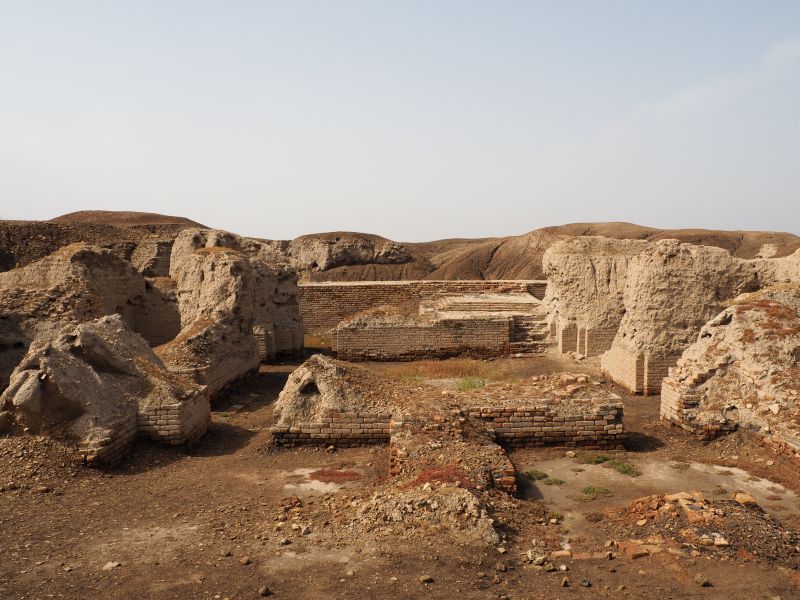The Cemeteries at Ur
The Royal Cemeteries of Ur
The Royal Cemeteries were initially discovered in Woolley’s first season when he dug a test trench. However, he did not begin full excavations until the start of his fifth season and continued until his eleventh season. The cemetery measured 55 meters northwest to southeast, with depths varying between 10 to 13 meters. Two cemeteries were found, one above the other that consisted burials identified as the graves of commoners, and graves identified as the tombs of the kings, although he excavated more than a thousand graves, only sixteen were classified as royal. However, due to the richness of the grave goods from those 16 tombs, the entire cemetery has since been known as The Royal Cemeteries of Ur. Additionally, Woolly discovered what he called death-pits that involved the sacrificial burial of the attendants or servants of kings and queens. The most famous of these was designated ‘The Great Death Pit,’ where Woolley found seventy-seven sacrificed attendants dressed in elaborate costumes of gold, silver, lapis and shell.
The upper graves that were located at a depth of between 5 and 7 meters, and dated to the time of Sargon of Akkad, first ruler of the Akkadian Empire. Methods of burials varied, including coffins made of either reeds, clay, or wood, with some of the wooden coffins having been placed in mudbrick lined grave-shafts, while others were simple interments of bodies wrapped in reed matting. Grave goods included cylinder seals, pottery, stone and metal vessels, as well as tools and weapons. However, Woolley noted that the vast majority of the Akkadian graves had been plundered during antiquity and grave goods were scarce. Below the Akkadian graves, Woolley found more commoner and royal graves. However, the lowest Akkadian and uppermost Royal Cemetery graves tended to be intermingled, which made some of the dating difficult. Sir Leonard Woolley differentiated the commoner or ordinary graves from the royal graves by certain characteristics they each exhibited.
The grave goods associated with the royal burials included gold and precious stones, musical instruments such as harps and lyres, and some of the most well-known objects such as the Royal Standard of Ur, the Ram in the Thicket, the Golden Helmet of Meskalamdug and Queen Puabi’s headdress.
The Great Death Pit (Jemdat Nasr Period)
Woolley discovered a third separate, even earlier cemetery in the southern corner of his dig site. It was not associated with the Akkadian or royal cemeteries. Rather, it was separated by debris consisting of decomposed mudbrick and pottery. Woolley’s team moved 13,160 cubic meters of earth in order to uncover the cemetery, which he dated to the Jemdat Nasr Period. He found that the bodies were buried in flexed fetal-like positions, and were either wrapped in reed matting, or enclosed in wooden, clay, or reed coffins. While the grave goods were not as elaborate as those recovered from the Royal Graves, he found archaic seal impressions, painted pottery, and stone and copper vessels, which helped further define and understand the Jemdat Nasr Period. A fourth area located southwest on the outskirts of the cemetery was initially explored by Woolley.
The Third Dynasty Cemeteries
The Mausoleum of King Shulgi and his Son Amar-Sin is the most important monument of the Third Dynasty after the Ziggurat of Ur-Nammu, the Cemeteries were excavated in Woolley’s eighth and ninth season. However, tombs for the rest of the kings, including Ur-Nammu the founder of the Third Dynasty, have not yet been located. The mausoleum was in actuality three distinct baked brick buildings that formed a superstructure measuring 35 meters in length by 27 meters in width.
- The Central Building: Stamped bricks bearing the name of King Shulgi are located throughout the largest central building, yet it remains uncertain if he was ever entombed within the structure. Woolley counted twelve rooms and two tomb chambers. He designated the tombs as the northwest chamber and the southeast chamber, and each was accessible via brick staircases. Both tombs had been looted and damaged in antiquity. However, Woolley did recover some human remains that indicated multiple burials. The rooms were in varying stages of preservation, with damage. Much of the structure was heavily damaged, initially by fire from the Elamite invasion, and later when Isin-Larsa builders constructed houses over the tombs.
- The Southeast Annex: the southeast annex were attributed to Amar-Sin, King Shulgi’s son. However, it is not definitively known if this was his tomb. The southeast annex had an identical floor plan to the central building, only on a smaller scale. The building consisted of a paved courtyard, 10 rooms and 2 burial chambers, surrounded by walls with slightly rounded corners. While much of the walls were preserved when Woolley conducted his excavations, he noted that Kassite houses had destroyed the eastern wall. Similarly, many of the floors had been destroyed or had disintegrated into dirt, but the burial chambers still retained floors made of bricks coated with bitumen. However, the tombs had been thoroughly plundered by the time Woolley found them. The most important find was located under room six, the conical stem of a chalice bearing an inscription dedicated to Gilgamesh. Woolley said: “It was an object rare in itself, but unfortunately threw no light on the ownership of the tomb.”
- The Northwest Annex: The northwest annex is also attributed to Amar-Sin; however, it is not likely that he would have been in possession of two tombs. Woolley did not find any artifacts that would shed light on the tomb’s occupant, and it remains unknown to this day whose burial chamber was located in the northwest annex. The building consisted of seven rooms, including a courtyard plus three burial chambers.
